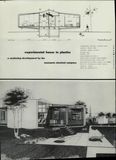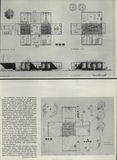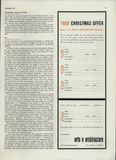


This preliminary design for an experimental house has been developed for the Monsanto Chemical Company in a broad program to develop sound uses of plastics for the construction industry. The basis of the design is a molded module, 8 by 16 feet, which is bent to form ceiling, wall and floor. In the simplest plan, eight molded modules are contilevered in pairs from a 16-foot-square central utility core to form four 16-foot-square rooms. The utility core itself contains baths, kitchen, laundry and heating facilities.
The project proceeds on the assumption that the molded module con achieve basic engineering purposes in a way possible only with plastics. Several combinations of the design components, including twin cores, con make possible a variety of floor plans. Rooms con easily and economically be added or removed to suit the changing space needs of the family. Also, it is obvious that the minimum of site excavation is required to accommodate the utility core, the elevation of which con be easily adopted to take advantage of terrain conditions. Lightweight movable partitions and curtain walls combining a variety of core and face materials in o sandwich construction will permit flexibility and indoor-outdoor living arrangement.
Decorative and durable laminates combining plastics with paper, wood or cloth for counter tops, walls and tables will be developed. Shatterproof and lightweight panels of glass-reinforced plastics in a variety of colors and degrees of tronslucency for transmission and control of light in new ways both inside and outside the house. Conduits, ducts and piping, much of it integrally formed into wall and floor sections, will be mode of flexible and corrosion-resistant plastics. Gaskets and stripping of plastics extruded in various cross sections will be used to seal openings and join panel sections.
The design is being refined at the Massachusetts Institute of Technology by architect Marvin Goody under the guidance of Richard W. Hamilton, director of the Monsonto-sponsored research project and research associate in the school's Department of Architecture. It is expected that the final design will be completed by the end of the year.